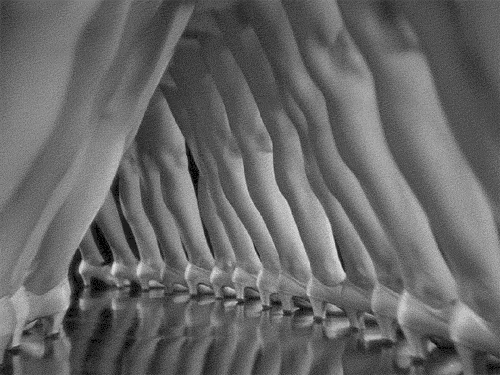If you've seen Zhang Yimou's opening ceremony and G20 performance at the Beijing Olympics, or the thigh dance in One Step Away or the carnival bird dance on the water in Rio Adventure, even the thigh shuttle in Murder Green Finger or the water dance of Resgal Johnson in Long Live Caesar, you've seen busby Berkeley (1895-1976) dance. Every year in world cinema class, I talk about him. In the 1930s, the Hollywood legend of song and dance films, Busby Berkeley, brought the camera vision to his unique stage performance, his song and dance wonder was not only as simple as choreography, he consciously used the light and sound of the film language, the camera angle and the illusion of depth of field, turning the dancers into dance props for the event, or the "Kaleidoscope of the Flesh Mountain Body" (the big strange language), making the Hollywood song and dance film reach its first glory. Of course, you will find that Teacher Zhang Yimou's "human spectacle" aesthetics and "group exercise" aesthetics used to the extreme in various opening ceremonies and performances have actually been fully exerted in this song and dance film director. Let's introduce this director today.
Some people say, Uncle Tiger, how do you introduce old movies again, no way, Uncle Yun is too busy, fresh, fashionable and interesting movies, Uncle Yun introduced, Uncle Tiger introduced old, strange, cold movies. 😄

Forty-second Street 42nd Street (1933)
Busby Berkeley, formerly known as William Berkeley Enos, was born on November 29, 1895 in Los Angeles, California. A famous director and one of the most famous dance directors in the history of American cinema, he has been nominated for three Oscars for Best Choreography.
Busby Berkeley
Busby Berkeley moved to New York at the age of three, performed on stage at the age of five, and later entered the Military Academy. During World War I, he was a field artillery lieutenant general, and after the war he served in the soldiers' camp musical. After retiring from the army and returning to the United States, he worked as a musical theater actor and assistant director in a small theater company. After directing the musical Holka-Polka, he discovered his talent for choreographing lavish dance scenes. Berkeley became one of Broadway's best dance directors.
Palmy Days (1931)
Gold Diggers of 1933 (1933)
Berkeley's talent and his success on Broadway were noticed by the film industry. He gradually worked as a dance director in a number of cabaret films. But at first, he was dissatisfied with the possibilities of his work being constrained by Hollywood filming methods—the dance director was responsible for training dancers and arranging the shots, while the editors decided which shots and how to present them to the audience. Berkeley wanted to take control of the dance footage himself.
Gold Diggers of 1935 (1935)
Dames (1934)
In 1931 and 1932, when the cabaret faded, Berkeley considered returning to the Broadway stage. At this time, Warner Bros. producer Daryl M. Darryl F. Zanuck asked him to direct a film version of the stage play Forty-second Street. The film was a huge success, and Warner immediately signed a seven-year contract with Berkeley, the segment's arranger Harry Warren, and the lyricist Al Dubin.
Thereafter, Berkeley directed dance passages from nearly all of Warner Bros. 's great musical films made between 1933 and 1937. His work was grand and the composition was novel, and in order to create better visual effects, Berkeley did not hesitate to drill holes in the roof of the studio, and with the success of his film, more and more dancers appeared in the film.
Night World (1932)
Footlight Parade (1933)
But in the second decline of the cabaret in 1938, he found himself with nothing to do as a dance director, and after directing two non-cabaret films for Warner Bros., he went to MGM, where he choreographed the final passage of the Broadway Serenade.
As a choreographer, he has created countless wonderful classic dance passages for other people's films, but his own achievements as a director are relatively small. In the 1940s and 1950s, he was still a choreographer and had also worked as a dance director for a number of British films. By the end of the 50s, Berkeley's name had been forgotten. Dramatically, in the late '60s, some of his early films were re-released, winning him attention. He was invited to serve as the dance supervisor for Broadway's classic rearrangement musical No, No, Nanette.
Izumi Hibiscus Million Dollar Mermaid (1952)
When Busby Berkeley meets "Water Dance Queen" Esther Williams
Berkeley himself had never taken a dance class, and he couldn't dance himself, but he had an incredible intuition about the film's dance design. In both dance and film, he has many unique creations.
First, he freed up the camera and put it on the camera to shoot the dance from different angles: to get the visual effect he wanted, he placed the camera on the crane, on the top of the actor's head, between their legs, underwater, on the building, and even on the roof to drill holes, and put the camera higher. And before he did, audiences had never seen dance from these particular angles, and it was that most Hollywood song and dance films looked like they were recording Broadway stage musicals.
Ever since Berkeley learned to train its troops during World War I, it has used this knowledge to the extreme. He is good at directing big dance scenes, allowing actors to make various movements and queues around the stage, sometimes reaching hundreds of dancers. The kaleidoscopic queues, geometric compositions, and close-ups of beautiful dancers and actresses became the hallmarks of Berkeley's films.
高朋满座 The Gang's All Here (1943)
Editor: Chealsea